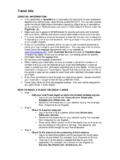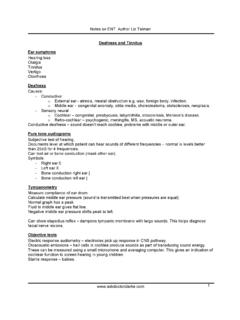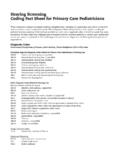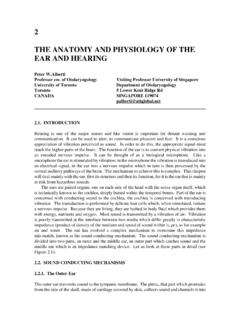Transcription of Grommet Insertion - ENT Surgery | Ear, Nose and …
1 Patient Advice Sheet on Grommet Insertion by P H Jones, ENT Consultant, Department of Otolaryngology Head & Neck Surgery South Manchester University Hospitals NHS Trust July 2003. What is in my ear? At the end of your ear canal is your eardrum. It is a piece of skin. It separates the middle ear from the ear canal. The eardrum collects the sound. Behind the drum is a space which is full of air. This is the middle ear cavity. The sound passes across this space through a chain of bones. It enters the inner ear. This is the organ of hearing itself. The middle ear cavity opens into the Eustachian tube. This passes into the back of your nose.
2 It is usually closed. It opens every few times you swallow. Air passes up into the middle ear. The pressure of the air in the middle ear is then the same as outside. Why have grommets inserted? If you have any of these problems grommets may help. Glue ear (also known as otitis media with effusion). This is the presence of sterile mucus in the middle ear space. It causes hearing loss. The Grommet (s) help your hearing. Earaches due to middle ear infections. The Grommet (s) stop infections and stop pain. Eustachian tube problems such as earache when landing in a plane. Meniere's syndrome the Grommet may help directly. Or we can put medicine into the ear through it.
3 What are grommets? Grommets are small plastic tubes. We can show you one. They fit in the eardrum. There are short and long term grommets. Short-term grommets come out in six to eighteen months. Long- term grommets may stay several years. We use them in adults only. We sometimes trim a long- term Grommet for use in children. How do they work? We do not always know. Grommets make the pressure in the middle ear the same as it is outside. This seems to help the ear stay healthy. Will I be asleep? We can use local anaesthetic (or LA) in adults. We freeze the eardrum with some cream. We use general anaesthetic (asleep) for children.
4 Some adults prefer a general anaesthetic (or GA). The doctor who makes you go to sleep is called an anaesthetist. He or she will tell you about your anaesthetic. What happens in the operation? We make a tiny cut in the ear drum. We use a microscope to see. We suck out any mucus and put in the Grommet (s). When can I go home? The operation is quick. You can go home the same day. After a GA you recover on the ward for two hours first. Will my ears be sore? Not usually. There is no need for medications to be taken. We give drops sometimes if the ear was infected. When will you look at my ears again? Usually in about 6 weeks in the clinic.
5 You will have a hearing test. We see you every 6 to 12. months until the grommets come out. Grommet Insertion How should I take care of my ears? Plain water will not go through a Grommet : it is too small. Water under pressure will go through a Grommet . Water with soap or shampoo in it will go through a Grommet . Take care when having a bath, shower or washing your hair. Place cotton wool with vaseline in your ears when washing your hair. You can swim if you want. Do not dive. Do not get soapy water in your ears. Are there any problems with grommets? Immediately afterwards your ear may be a little sore. You may feel dizzy. There may be a little bleeding.
6 Later infections may happen even if you are careful. If your ear runs phone the ENT Secretary or the Ward. We will see you straightaway. Long-term grommets are more likely to cause problems. About 9% have a hole in the ear drum which won't heal. This may need another operation. All operations and anaesthetics have risks. Some are serious. The risks are similar to those of everyday life. Examples are flying on holiday; driving in a car or walking down a street. Grommet Insertion is a very minor operation. What happens when the Grommet comes out? The eardrum usually heals behind it. Permanent holes in the eardrum are rare with short-term grommets.
7 If they happen it is probably due to the disease. It happens in less than 2% of cases. We can close such holes. Slight scarring of the ear drum is usual. It causes a slight loss of hearing. Your ear problems may come back. Do I have to have this operation? No. It is your choice. We call this elective. There are other treatments. They depend on the problem you have. Adenoidectomy can help ear infections and hearing loss. Hearing aids can help hearing loss. Antibiotics can help infections. May I ask a question? At any time. You can also refuse to have the operation at any time. If you ask a question please ask someone suitable. A junior doctor or nurse may not know what you want to know.
8 Please do not ask several doctors the same question and compare answers. Page 2.






